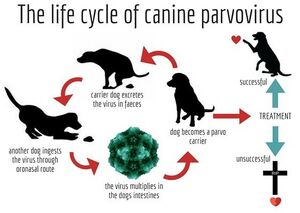Parvovirus B19: Difference between revisions
| Line 3: | Line 3: | ||
<b>By Grace Potter <br> | <b>By Grace Potter <br> | ||
<i>Parvovirus B19</i> is the only member of the <i>Parvoviridae</i> family that has been found to infect human hosts.<ref name=ncbi/> It was discovered in 1974, when a research group looking at hepatitis B surface antigens found a serum sample with unexpected results.<ref name=ncbi/> Another lab in Japan described a similar virus in 1979 that they called "Nakatami".<ref name=ncbi/> When compared, the two were found to be identical.<ref name=ncbi/> | <i>Parvovirus B19</i> is the only member of the <i>Parvoviridae</i> family that has been found to infect human hosts.<ref name=ncbi>[https://www.ncbi.nlm.nih.gov/pmc/articles/PMC118081/#:~:text=Parvovirus%20B19%20(B19)%20was%20discovered%20serendipitously%20in%201974%20and%20is,hematologic%20status%20of%20the%20host. Heegaard, E.D. and Brown, K.E. "Human Parvovirus B19." 2002. Clinical Microbiology Review 15(3):485-505.]</ref> It was discovered in 1974, when a research group looking at hepatitis B surface antigens found a serum sample with unexpected results.<ref name=ncbi/> Another lab in Japan described a similar virus in 1979 that they called "Nakatami".<ref name=ncbi/> When compared, the two were found to be identical.<ref name=ncbi/> | ||
In 1985 this virus was officially recognized as a member of the <i>Parvoviridae</i> family due to its similarities in genome size and density.<ref name=ncbi/> | In 1985 this virus was officially recognized as a member of the <i>Parvoviridae</i> family due to its similarities in genome size and density.<ref name=ncbi/> | ||
Revision as of 20:44, 5 April 2024
Background

By Grace Potter
Parvovirus B19 is the only member of the Parvoviridae family that has been found to infect human hosts.[1] It was discovered in 1974, when a research group looking at hepatitis B surface antigens found a serum sample with unexpected results.[1] Another lab in Japan described a similar virus in 1979 that they called "Nakatami".[1] When compared, the two were found to be identical.[1]
In 1985 this virus was officially recognized as a member of the Parvoviridae family due to its similarities in genome size and density.[1]
Section 1
Include some current research, with at least one figure showing data.
Parvoviridae
Genome Structure
The Parvovirus genome is a single strand of DNA with 5,596 nucleotides, 4,830 of which are coding regions.[1] This region contains 2 large open reading frames.[1] One large non-structural protein is coded by one open reading frame, and the second reading frame codes for 2 capsid proteins.[1]
Section 3
Include some current research, with at least one figure showing data.
Section 4
Conclusion
References
Authored for BIOL 238 Microbiology, taught by Joan Slonczewski,at Kenyon College,2024
